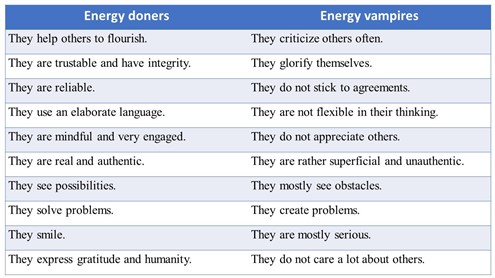
Why Positive Leadership is a good remedy against energy vampires

Dr. Markus Ebner , MSc.
Organizational Psychologist/Founder of the PERMA-Lead Model

Stefanie Krauth
Studienassistentin, Universität Wien
Without ever having dealt with it scientifically, surely everyone knows people who energize just by being present. Unfortunately, most of us also know the opposite: Namely people who make you feel tired and drained after every interaction with them. These are often experienced as literal energy vampires.
The (former) professors Wayne Baker and Kim Cameron (Positive Leadership pioneer) from the University of Economics in Michigan describe this phenomenon as Relational Energy.
 A phenomenon that can be measured scientifically
A phenomenon that can be measured scientifically
Relational Energy, as it is called in the original – can be defined as a feeling characterized by liveliness, excitement, vitality and vigor. What at first glance sounds like a description from an esoteric book is actually scientifically proven. Positive energy, as Relational Energy is called in German, releases inner resources and capacities and increases our ability to develop strengths. People who are described by others as having positive energy are usually high performers themselves. And they are four times more likely to be high performers than those who are described as particularly influential or have a lot of information at their disposal. Positive energy is not an equivalent to motivation. Depending on the approach, motivation includes a concrete sense of purpose, needs that are usually not yet fulfilled, expectations or other aspects. Positive energy, on the other hand, corresponds more to a fundamental energy and is thus a core element for activation.
This positive energy not only affects people themselves, but has a strong influence on other people as well. Studies show that employees who have a working relationship with an energy donor perform measurably better and that there are three times (!) as many positive energy networks in high-performance companies as in low-performance companies. We think that raising awareness about this topic is crucial because it is often certain people in a team who influence the whole team through their positive energy, but this cannot be surveyed with classic performance measurement. Nevertheless, these individuals significantly influence performance - namely the performance of the others.
 Can Positive Leaders influence team dynamics?
Can Positive Leaders influence team dynamics?
“Does leadership style generally influence team culture?” – is how this question could be put more broadly. Scientific research indicates that this is definitely the case. Leaders, whether they want to or not, provide a behavioral framework. Which behaviors are rewarded by the leader, which violate the norm, and let's not forget: Which ones are tolerated without sanction? These are important questions that every person with leadership responsibility should address. The respective leadership behavior has a decisive influence on the behavioral norms emerge in the team.
Is positive leadership particularly effective in fostering a positive team culture? This is precisely the question we investigated in our current study.
Positive Leadership and Relational Energy - the study
In this study, we specifically wanted to address the question of whether Positive Leadership has a measurable effect on the proportion of energy vampires or energy givers in the team.
A total of 239 people participated in the current study. They were asked to complete psychological questionnaires (Relational Energy Scale by Owens) on the experienced relationship quality with their leader as well as with their colleagues. This made it possible to distinguish between two forms of Relational Energy: The Relational Energy between the leader and the employees and the Relational Energy among the employees.
Furthermore, the positive leadership behavior of the respective direct leader was measured with the PERMA-Lead Profiler.
The results revealed a definite connection between the leadership behavior and the Relational Energy experienced within the team.
 Those teams whose leader is a Positive Leader bring out more energizing behaviors in the individual team members. Our findings show that these teams have greater stamina, more energy to get the job done, and greater vitality.
Those teams whose leader is a Positive Leader bring out more energizing behaviors in the individual team members. Our findings show that these teams have greater stamina, more energy to get the job done, and greater vitality.
As expected, this effect is even more dramatic in the case of Relational Energy between the employees and the leader himself. In this study, we were also interested in the extent to which leadership behavior makes the leader himself an energy donor or rather an energy vampire. The following graphic speaks a clear language.
 Leaders who exhibit little Positive Leadership behavior are experienced as literal energy vampires. They do not only have a questionable leadership style, but their employees also describe that they feel less energetic after contact with their leader, have less energy to do their work and also that their stamina decreases noticeably.
Leaders who exhibit little Positive Leadership behavior are experienced as literal energy vampires. They do not only have a questionable leadership style, but their employees also describe that they feel less energetic after contact with their leader, have less energy to do their work and also that their stamina decreases noticeably.
Whereas those who are described as true Positive Leaders have a measurable vitalizing effect on their employees, which also leads to them feeling more alive when dealing with their leader. This in turn releases inner resources and capacities and increases the ability to develop one's own strengths.
 How do leaders become energizers?
How do leaders become energizers?
In a study, participants were asked if they had ever had a colleague, employee or leader who energized them through their presence. Fifty-nine percent of the respondents could think of a current or former leader. 59 percent! Perhaps that number may not seem so small to some. But if one of the most important tasks of a leader is to ensure that employees have energy that is beneficial to their work, then it seems shocking that around 40 percent of employees have not had any experience with energizing leaders in their working lives. That's problematic - but changeable.
So what exactly do leaders who are energizers differently from those who are experienced as energy vampires? A team of researchers asked people this very question (Owens, Baker, Sumpter & Cameron). They asked leaders what characteristics they experience in energy givers and energy suckers. Here is the result:

Über die Autor*innen
Dr. Markus Ebner, MSc.
Organizational Psychologist/Founder of the PERMA-Lead Model
He teaches leadership at several universities and colleges, has written numerous books and publications in this field, and has additional training in coaching, supervision, crisis intervention, social pedagogy, and organizational and team development. In addition to his more than 20 years of work as a trainer, coach and consultant, he is the founder of the PERMA Lead Model and, as one of the renowned European experts on Positive Leadership, is on the Board of Directors of the Austrian Umbrella Association for Positive Psychology. In 2021, he was awarded the Exemplary Research to Practice Award by the World Positive Psychology Association (IPPA) for his work.
Stefanie Krauth
Studienassistentin, Universität Wien
Stefanie Krauth is about to complete her master's degree in psychology with a focus on work-, economic- and social psychology. She studied at the University of Vienna. Her research interests are in the fields of social psychology (e.g., decisions in social situations) and in work psychology (e.g., leadership behavior and organizational processes). The study results in this blog article are additional analyses from data collected as part of the project for her master's thesis.

